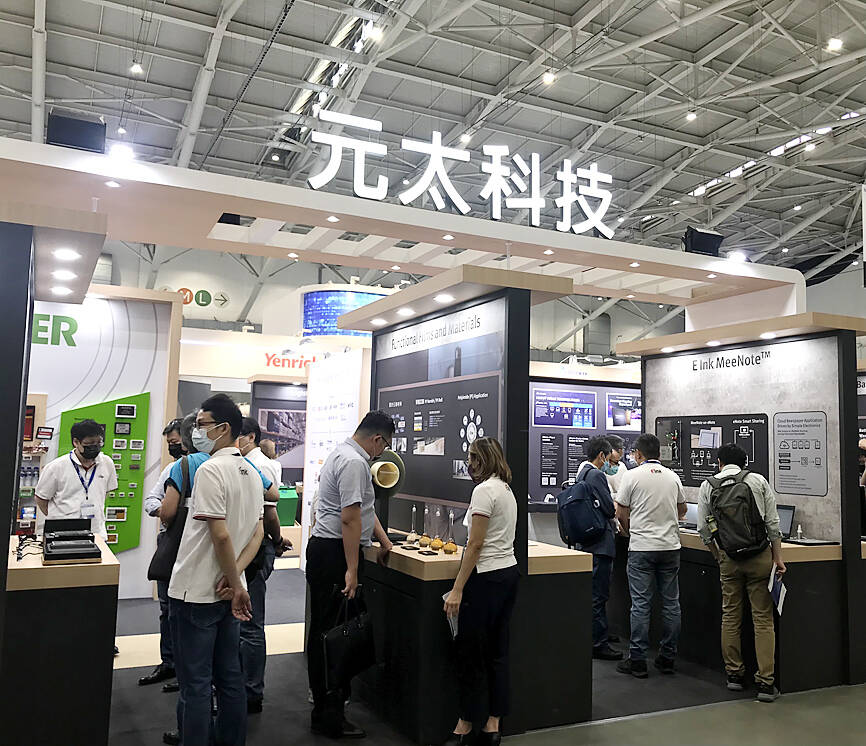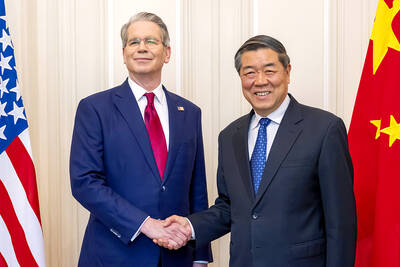E Ink Holdings Inc (元太科技), the world’s biggest e-paper display supplier, yesterday cut its revenue growth forecast for this year again, following a downward revision in August, as its supply chain partners continue to address excess inventories of three-color e-paper displays used in electronic shelf labels (ESL).
The downgraded revenue forecast also reflected slower demand for its new e-paper displays among many of its e-reader and e-note customers, who have postponed plans to use color displays to next year, E Ink said.
The company had expected the technology transition from monochromatic displays to new color displays to take place in the second half of this year.

Photo: Chen Mei-ying, Taipei Times
“The fourth quarter will be weaker than we thought. The first quarter next year will be the lowest point,” E Ink chairman Johnson Lee (李政昊) told an online investors’ conference.
However, there are encouraging signs for the company’s business outlook after some customers reported sales surged 30 to 40 percent on average with the launch of color-display e-readers and e-notes, Lee said.
System integrators installing ESLs are “relatively bullish” about next year’s business prospects, he said.
“We believe the headwinds we are facing now are short-term and the company will be able to sustain growth in the long term,” he said.
Inventories in supply-chain firms would return to healthy levels by the end of the first quarter of next year at the earliest, as customers have taken longer to switch to more advanced four-color display ESLs than the company had expected, Lee said.
From the second quarter of next year, revenue is expected to start picking up every quarter, he said.
Hopefully, the ESL penetration rate would rise to a double-digit percentage from single digits after supply-chain inventories return to healthy levels, he added.
Despite the inventory pressure, E Ink expects its new full-color e-paper displays to enter volume production next quarter.
E Ink reported a 43 percent slump in net profit last quarter to NT$2.4 billion (US$74.75 million), compared with NT$4.24 billion a year earlier.
On a quarterly basis, it was little changed from the previous quarter’s NT$2.42 billion.
Earnings per share dipped to NT$2.1 last quarter from NT$7.08 in the same quarter last year and down slightly from NT$2.12 the previous quarter.
Royalty income from licensing its South Korean subsidiary’s LCD patent fell to about NT$79.74 million last quarter, from NT$223 million a year earlier.
“We have been collecting royalties for more than 10 years. It is gradually approaching the end of its life,” Lee said.

Jensen Huang (黃仁勳), founder and CEO of US-based artificial intelligence chip designer Nvidia Corp and Taiwan Semiconductor Manufacturing Co (TSMC, 台積電) on Friday celebrated the first Nvidia Blackwell wafer produced on US soil. Huang visited TSMC’s advanced wafer fab in the US state of Arizona and joined the Taiwanese chipmaker’s executives to witness the efforts to “build the infrastructure that powers the world’s AI factories, right here in America,” Nvidia said in a statement. At the event, Huang joined Y.L. Wang (王英郎), vice president of operations at TSMC, in signing their names on the Blackwell wafer to

AI BOOST: Although Taiwan’s reliance on Chinese rare earth elements is limited, it could face indirect impacts from supply issues and price volatility, an economist said DBS Bank Ltd (星展銀行) has sharply raised its forecast for Taiwan’s economic growth this year to 5.6 percent, citing stronger-than-expected exports and investment linked to artificial intelligence (AI), as it said that the current momentum could peak soon. The acceleration of the global AI race has fueled a surge in Taiwan’s AI-related capital spending and exports of information and communications technology (ICT) products, which have been key drivers of growth this year. “We have revised our GDP forecast for Taiwan upward to 5.6 percent from 4 percent, an upgrade that mainly reflects stronger-than-expected AI-related exports and investment in the third

RARE EARTHS: The call between the US Treasury Secretary and his Chinese counterpart came as Washington sought to rally G7 partners in response to China’s export controls China and the US on Saturday agreed to conduct another round of trade negotiations in the coming week, as the world’s two biggest economies seek to avoid another damaging tit-for-tat tariff battle. Beijing last week announced sweeping controls on the critical rare earths industry, prompting US President Donald Trump to threaten 100 percent tariffs on imports from China in retaliation. Trump had also threatened to cancel his expected meeting with Chinese President Xi Jinping (習近平) in South Korea later this month on the sidelines of the APEC summit. In the latest indication of efforts to resolve their dispute, Chinese state media reported that

CHINESE EXPORT CURBS: A dispute between China and the Netherlands could halt chip supply, affecting vehicle production, US and European auto associations said Groups representing major automakers late on Thursday warned that a chip disruption stemming from a dispute between China and the Dutch government could quickly affect US auto production. Automakers and their suppliers received notice from chipmaker Nexperia (安世半導體) last week that it could no longer guarantee delivery of its chips, the European Automobile Manufacturers Association said, adding that manufacturing could be significantly disrupted. In the US, the Alliance for Automotive Innovation, which represents General Motors, Toyota, Ford, Volkswagen, Hyundai and nearly all other major automakers, urged a quick resolution. “If the shipment of automotive chips doesn’t resume — quickly — it’s going to